Method for Determining the Susceptibility of the Track
Abstract
:1. Introduction
2. Experimental Testing on a Real Object
2.1. Vertical Stiffness Measurements of Straight Track
- –
- variant simulating the vertical forces acting between the railhead and the empty wagon (nominal force ,
- –
- variant simulating the vertical forces acting between the head of a rail and a loaded wagon (nominal force .
2.2. Stiffness Calculations in the Turnout
- (a)
- the cross-beam is a beam of real length with variable moment of inertia and cross-section (Figure 7 curve 1) supported on elastic supports (turnout sleepers),
- (b)
- the cross-beam is a beam of infinite length supported on a continuous elastic support; the moment of inertia of the cross-section can be taken as constant (averaged).
- E = 2.1 × 105 MN/m2—Young’s modulus of the rail steel,
- J = 10 × 10−5 m4—average moment of inertia of the cross section,
- Pi—load from the next wheel,
- ηi—ordinates of the influence line of settlement of an infinitely long beam resting on a continuous elastic foundation,
- U—support factor of the rail,
- C—ground coefficient,
- α = 0.8—ratio of the average settlement of the subgrade to its settlement under the rail,
- l = 2 m—half of the average length of the turnout sleeper,
- b = 0.26 m—width of the subgrade base,
- a = 0.6 m—axial spacing of the turnout.
- –
- the ktz coefficient between the specified extreme values varies linearly,
- –
- the influence of the crossover has not been taken into account (some increase in stiffness in the section where the switch is adjacent to the bearer),
- –
- in the crossover section, the value of ktz is assumed to be constant (averaged),
- –
- the influence of the rib washers was not taken into account.
2.3. Experimental Determination of the Vertical Stiffness Coefficient of the Crossroads
3. Conclusions
Author Contributions
Funding
Institutional Review Board Statement
Informed Consent Statement
Conflicts of Interest
References
- Zeng, Z.; Xiao, Y.; Wang, W.; Huang, Z.; Wei, W.; Houdou, S.B. Research on Dynamic Performance of CRTSⅢ Type Slab Ballastless Track under Long-Term Service. Materials 2022, 15, 2033. [Google Scholar] [CrossRef]
- Jokūbaitis, A.; Marčiukaitis, G.; Valivonis, J. Experimental Research on the Behavior of the Rail Seat Section of Different Types of Prestressed Concrete Sleepers. Materials 2020, 13, 2432. [Google Scholar] [CrossRef] [PubMed]
- Kisilowski, J.; Kowalik, R. Numerical Testing of Switch Point Dynamics—A Curved Beam with a Variable Cross-Section. Materials 2020, 13, 701. [Google Scholar] [CrossRef] [PubMed] [Green Version]
- Nishiura, D.; Sakaguchi, H.; Aikawa, A. Development of Viscoelastic Multi-Body Simulation and Impact Response Analysis of a Ballasted Railway Track under Cyclic Loading. Materials 2017, 10, 615. [Google Scholar] [CrossRef] [PubMed] [Green Version]
- Silva, R.; Silva, W.V.; de Farias, J.Y.; Santos, M.A.A.; Neiva, L.O. Experimental and Numerical Analyses of the Failure of Prestressed Concrete Railway Sleepers. Materials 2020, 13, 1704. [Google Scholar] [CrossRef] [Green Version]
- Kisilowski, J.; Kowalik-Adamczyk, E. Stochastic Technical Stability Test of a Passenger Railroad Car Crossing a Turnout. Energies 2021, 14, 4569. [Google Scholar] [CrossRef]
- Xiao, Y.; Chang, Z.; Mao, J.; Zhou, S.; Wang, X.; Wang, W.; Cai, D.; Zhu, H.; Long, Y. Evaluating the Effect of Rail Fastener Failure on Dynamic Responses of Train-Ballasted Track-Subgrade Coupling System for Smart Track Condition Assessment. Materials 2022, 15, 2675. [Google Scholar] [CrossRef] [PubMed]
- Xiao, Y.; Jiang, Y.; Tan, P.; Kong, K.; Ali, J.; Mustafina, R.; Zhu, H.; Cai, D. Investigating Morphology and Breakage Evolution Characteristics of Railroad Ballasts over Distinct Supports Subjected to Impact Loading. Materials 2022, 15, 6295. [Google Scholar] [CrossRef] [PubMed]
- Sol-Sánchez, M.; Moreno-Navarro, F.; Rubio-Gámez, M.C. The Use of Deconstructed Tires as Elastic Elements in Railway Tracks. Materials 2014, 7, 5903–5919. [Google Scholar] [CrossRef] [PubMed] [Green Version]
- Kisilowski, J.; Kowalik, R. Railroad Turnout Wear Diagnostics. Sensors 2021, 21, 6697. [Google Scholar] [CrossRef] [PubMed]
- Ma, H.; Chen, W.; Li, X.; Xu, Q.; Lou, P.; Tong, C. Analysis on Damage and Mechanical Properties of Ballastless Track in a Tunnel after a Fire. Materials 2022, 15, 6712. [Google Scholar] [CrossRef] [PubMed]
- Xu, Q.; Sun, S.; Xu, Y.; Hu, C.; Chen, W.; Xu, L. Influence of temperature gradient of slab track on the dynamic responses of the train-CRTS III slab track on subgrade nonlinear coupled system. Sci. Rep. 2022, 12, 14638. [Google Scholar] [CrossRef] [PubMed]
- Gundavaram, D.; Hussaini, S.K.K. Polyurethane-based stabilization of railroad ballast—A critical review. Int. J. Rail Transp. 2018, 7, 219–240. [Google Scholar] [CrossRef]
- Xu, Y.; Xiao, J.; Jiang, T.; Zhuang, L.; Jing, P.; Wang, P.; Qi, T. The sleeper group influences on lateral resistance and stability of ballast bed. Int. J. Rail Transp. 2022, 1–16. [Google Scholar] [CrossRef]
- Kisilowski, J.; Skopińska, H. Dynamika krzyżownicy rozjazdu zwyczajnego. In Archiwum Inżynierii Lądowej—Tom XXIX 4/83; Politechnika Warszawska: Warszawa, Poland, 1983. [Google Scholar]
- Glusberg, B.E. Testing of Wheelsets on Railway Turnouts; WNIIST: Warszawa, Poland, 1997; Volume 2. [Google Scholar]
- Sysyn, M.; Przybylowicz, M.; Nabochenko, O.; Kou, L. Identification of Sleeper Support Conditions Using Mechanical Model Supported Data-Driven Approach. Sensors 2021, 21, 3609. [Google Scholar] [CrossRef] [PubMed]
- Sysyn, M.; Przybylowicz, M.; Nabochenko, O.; Liu, J. Mechanism of Sleeper–Ballast Dynamic Impact and Residual Settlements Accumulation in Zones with Unsupported Sleepers. Sustainability 2021, 13, 7740. [Google Scholar] [CrossRef]
- Kou, L.; Sysyn, M.; Fischer, S.; Liu, J.; Nabochenko, O. Optical Rail Surface Crack Detection Method Based on Semantic Segmentation Replacement for Magnetic Particle Inspection. Sensors 2022, 22, 8214. [Google Scholar] [CrossRef]
- Sysyn, M.; Gerber, U.; Liu, J.; Fischer, S. Studying the Relation of the Residual Stresses in the Ballast Layer to the Elastic Wave Propagation. Transp. Infrastruct. Geotechnol. 2022, 1–26. [Google Scholar] [CrossRef]
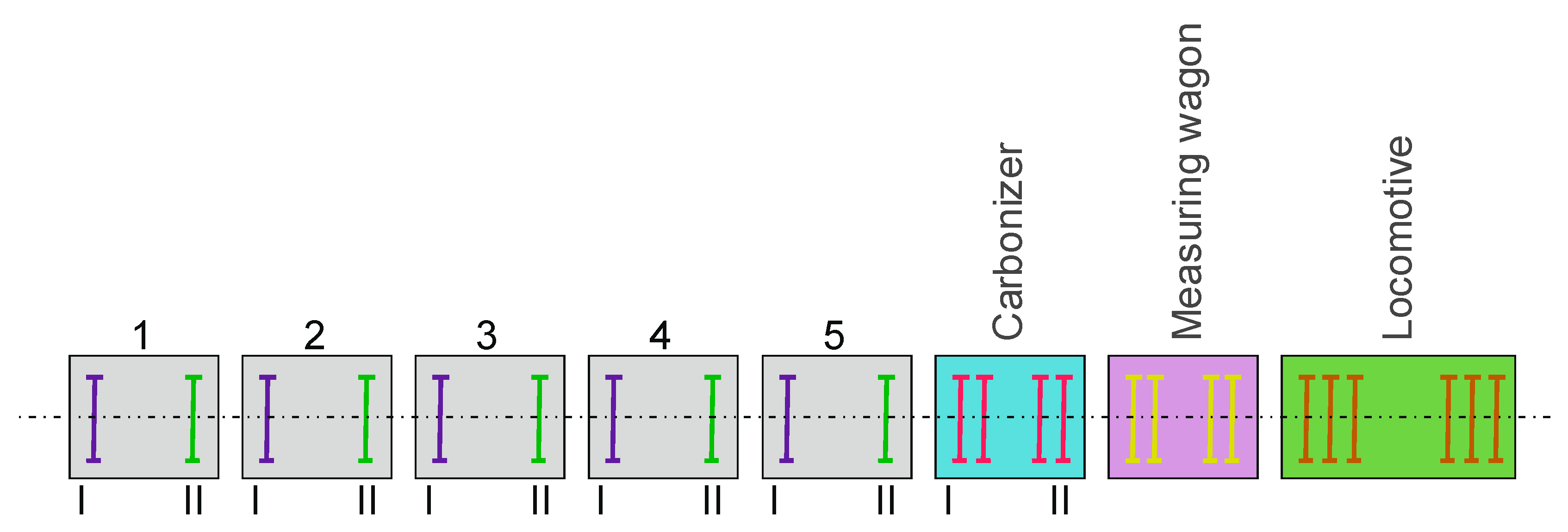

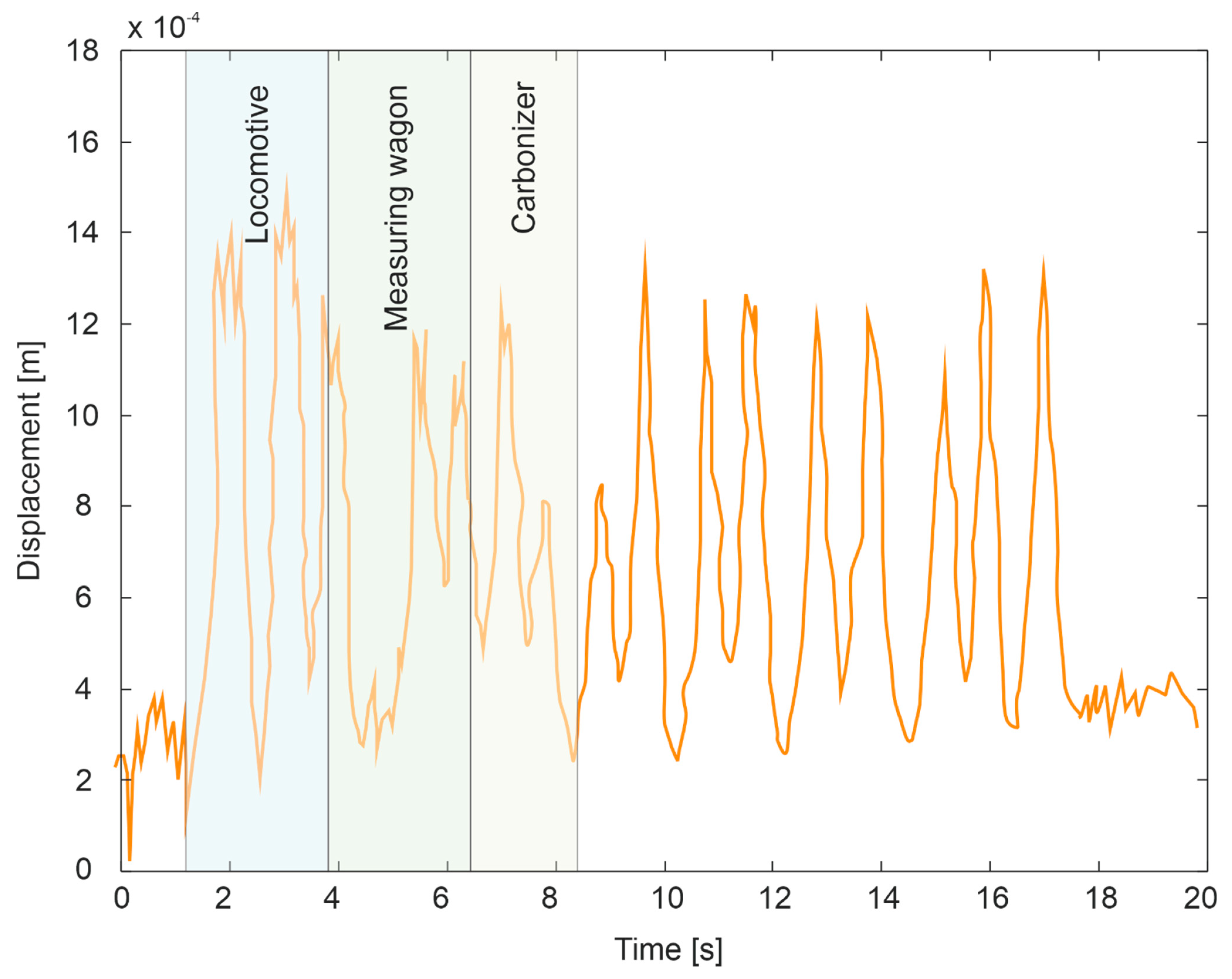
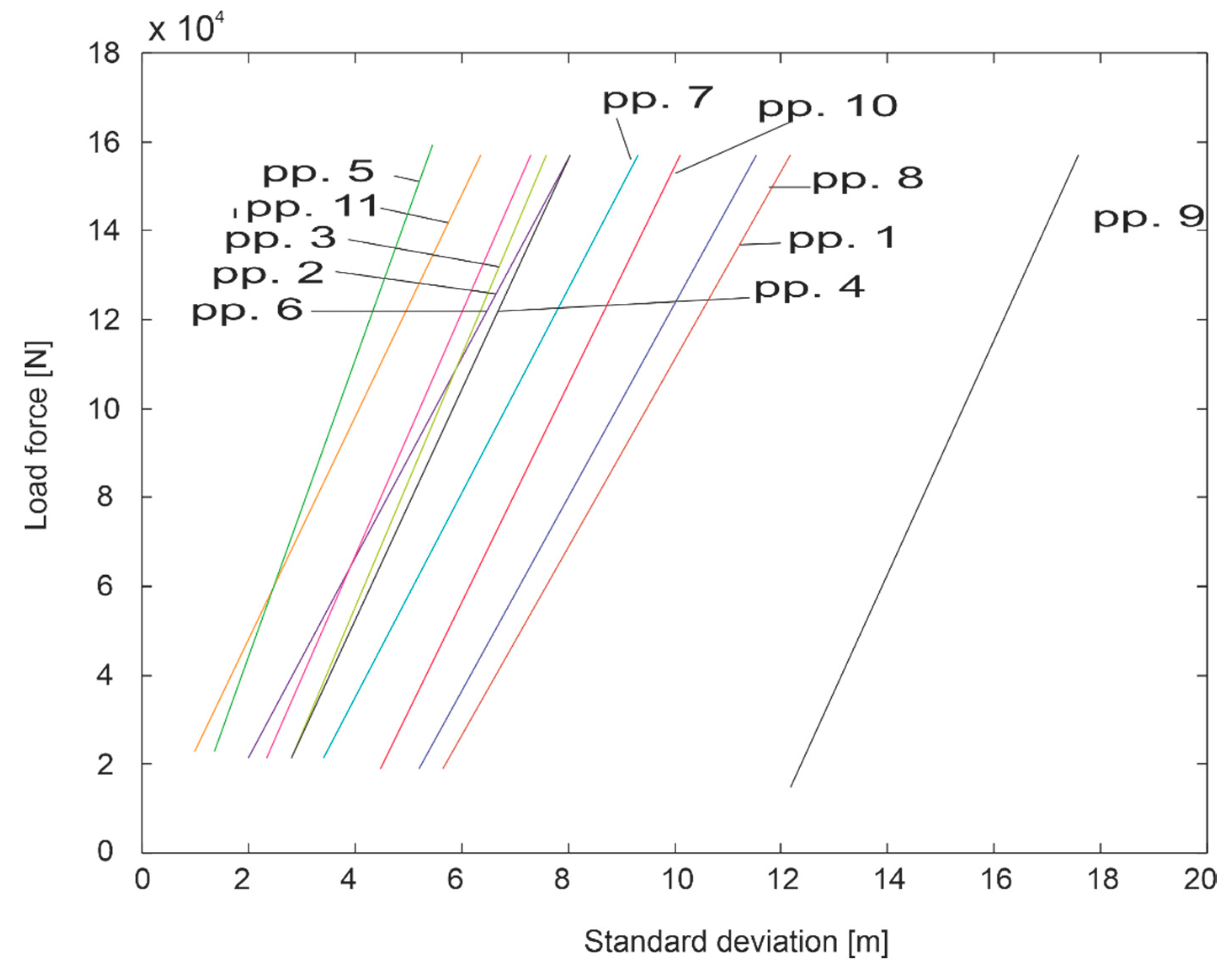


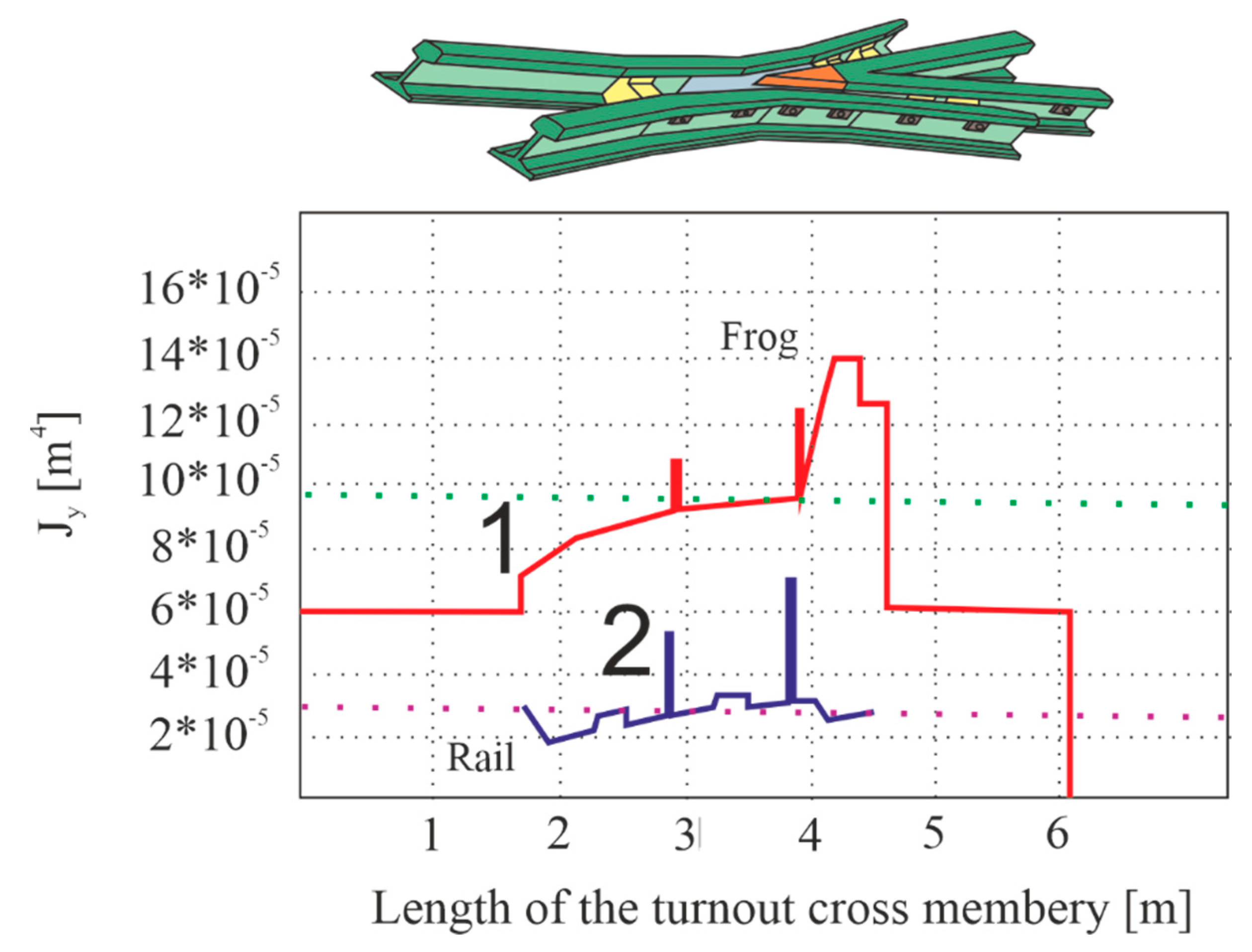
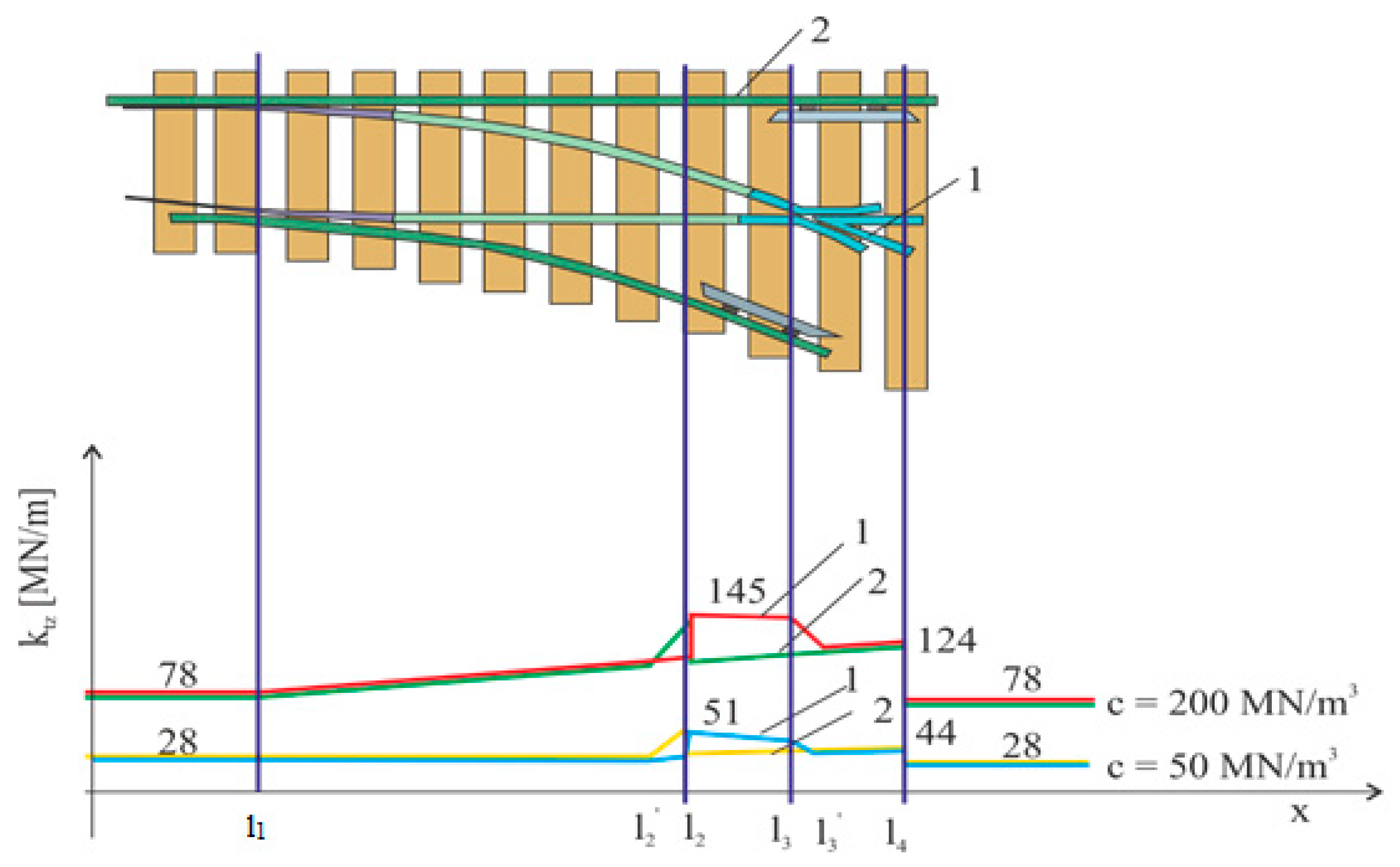
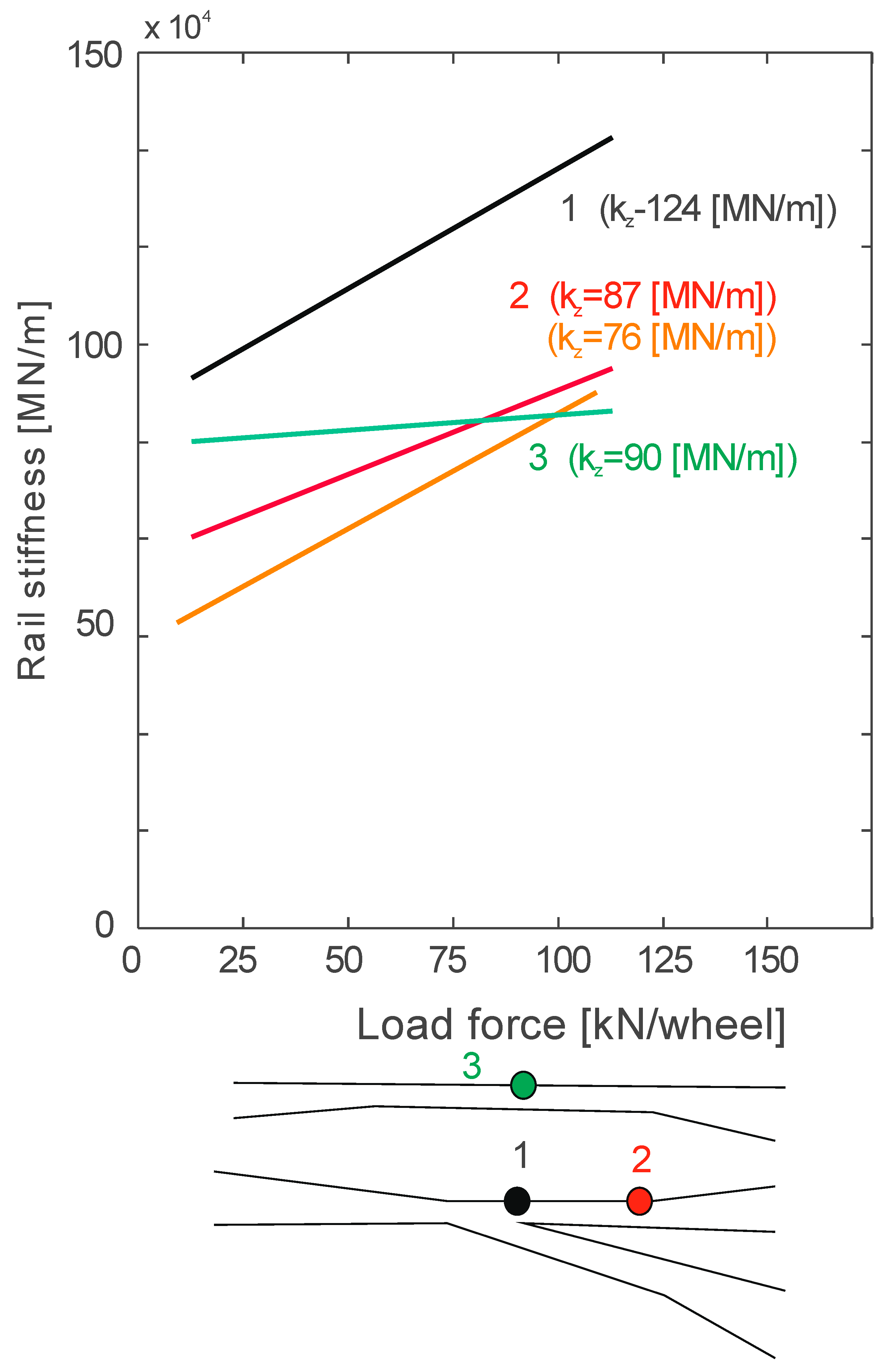
| No. | Gross Axle Load of the Two-Axle Platforms, N | ||
|---|---|---|---|
| Platform | I Axle | II Axle | |
| 1 | 400,000 | 208,000 | 192,000 |
| 2 | 217,000 | 83,000 | 134,000 |
| 3 | 347,000 | 150,000 | 197,000 |
| 4 | 366,000 | 155,000 | 211,000 |
| 5 | 124,000 | 62,000 | 62,000 |
| Gross load capacity of a coal truck with bogies 25 T N | |||
| coalminer, N | I Bogie, N | II Bogie, N | |
| 6 | 387,000 | 193,500 | 193,500 |
on a Wheel | |||||||||||
|---|---|---|---|---|---|---|---|---|---|---|---|
| p.p.1 | p.p.2 | p.p.3 | p.p.4 | p.p.5 | p.p.6 | p.p.7 | p.p.8 | p.p.9 | p.p.10 | p.p.11 | |
| 3.1 | 8.86 | 5.88 | 5.24 | 5.60 | 3.90 | 5.22 | 6.04 | 8.16 | 16.42 | 6.82 | 3.88 |
| 3.1 | 8.18 | 5.83 | 5.18 | 5.30 | 3.72 | 4.76 | 6.28 | 7.90 | 15.44 | 6.86 | 3.45 |
| 4.15 | 10.28 | 7.53 | 6.98 | 7.34 | 5.54 | 6.90 | 8.16 | 11.28 | 17.76 | 9.22 | 4.83 |
| 6.7 | 11.84 | 7.99 | 7.68 | 8.22 | 6.36 | 7.58 | 9.54 | 12.58 | 18.82 | 10.50 | 5.28 |
| 7.5 | 12.68 | 8.59 | 7.62 | 8.82 | 6.30 | 8.52 | 9.10 | 12.02 | 19.28 | 10.36 | 6.38 |
| 7.75 | 12.88 | 9.05 | 7.96 | 9.24 | 6.76 | 8.98 | 10.04 | 12.42 | 19.19 | 11.18 | 6.88 |
| 9.6 | 13.70 | 9.13 | 9.30 | 9.62 | 7.44 | 9.40 | 11.08 | 13.58 | 20.00 | 11.88 | 7.08 |
| 9.85 | 13.78 | 9.35 | 9.18 | 10.32 | 7.44 | 9.88 | 11.30 | 13.82 | 20.72 | 12.04 | 6.80 |
| 10.4 | 14.33 | 10.33 | 9.28 | 10.26 | 7.76 | 10.50 | 11.32 | 14.10 | 20.74 | 12.24 | 7.65 |
| 10.55 | 14.29 | 9.75 | 9.86 | 10.50 | 8.22 | 10.04 | 11.60 | 14.78 | 20.68 | 12.92 | 7.33 |
| Standard Deviationm | |||||||||||
| 3.1 | 0.71 | 1.15 | 0.23 | 0.92 | 0.30 | 0.35 | 0.27 | 0.62 | 0.40 | 0.20 | 0.64 |
| 3.1 | 0.77 | 0.92 | 0.49 | 1.27 | 0.29 | 0.76 | 0.56 | 0.31 | 0.31 | 0.22 | 0.53 |
| 4.15 | 0.61 | 0.62 | 0.08 | 1.19 | 0.28 | 0.80 | 0.45 | 0.54 | 0.73 | 0.29 | 0.39 |
| 6.7 | 0.46 | 1.10 | 0.65 | 1.21 | 0.30 | 0.70 | 0.30 | 0.67 | 0.56 | 0.54 | 0.35 |
| 7.5 | 0.58 | 0.78 | 0.72 | 1.19 | 0.25 | 0.68 | 0.28 | 0.61 | 0.69 | 0.55 | 0.51 |
| 7.75 | 0.99 | 1.33 | 0.62 | 1.69 | 0.29 | 0.73 | 0.68 | 0.51 | 0.59 | 0.46 | 1.43 |
| 9.6 | 0.77 | 1.00 | 0.48 | 0.78 | 0.21 | 0.39 | 0.41 | 0.45 | 0.88 | 0.38 | 0.43 |
| 9.85 | 0.72 | 1.43 | 0.44 | 1.46 | 0.30 | 0.66 | 0.55 | 0.59 | 0.55 | 0.36 | 0.89 |
| 10.4 | 0.63 | 1.00 | 0.41 | 1.30 | 0.43 | 0.82 | 0.51 | 0.77 | 0.99 | 0.72 | 0.65 |
| 10.55 | 0.86 | 1.12 | 0.29 | 1.32 | 0.44 | 0.37 | 0.42 | 0.39 | 0.56 | 0.38 | 1.42 |
| p.p.1 | p.p.2 | p.p.3 | p.p.4 | p.p.5 | p.p.6 | p.p.7 | p.p.8 | p.p.9 | p.p.10 | p.p.11 |
|---|---|---|---|---|---|---|---|---|---|---|
| 0.99 | 0.94 | 0.95 | 0.98 | 0.97 | 0.97 | 0.97 | 0.94 | 0.98 | 0.97 | 0.93 |
| Correlation Coefficients between: | Pi a zl under Load | Pi a zp under Load | Pi a zl under Load | Pi a zp under Load | Pi a zl Medium | Pi a zp Medium |
|---|---|---|---|---|---|---|
| when simulating a lighter wagon | 0.997 | 0.996 | 0.975 | 0.988 | 0.993 | 0.991 |
| when simulating a loaded wagon | 0.998 | 0.997 | 0.992 | 0.988 | 0.997 | 0.996 |
| Data Per Wheel | Empty Wagon (Nominal Load) | Payload Wagon (Nominal Load) | ||
|---|---|---|---|---|
| kT N/m | hT N | kT N/m | hT N | |
| Left rail | ||||
| Right rail | ||||
| Average values | ||||
| Turnout Type | Length of Section [m] | ||||
|---|---|---|---|---|---|
| Rz S60-190-1: 9 | 19.6 | 1.8 | 2.5 | 1.3 | 4.3 |
| Rz S60-300-1: 9 | 25.6 | 1.9 | 3 | 1.4 | 5 |
| Rz S60-500-1: 12 | 33.3 | 1.7 | 3.5 | 1.5 | 5.9 |
| Rz S60-1200-1: 18.5 | 50.2 | 4.2 | 4.9 | 4 | 8.3 |
| Point | Location | ktx MN/m |
|---|---|---|
| 1 | at the blade | 124 |
| 2 | 1.3 m behind the blade | 87 |
| 3 | outer rail opposite the blade | 63 |
Publisher’s Note: MDPI stays neutral with regard to jurisdictional claims in published maps and institutional affiliations. |
© 2022 by the authors. Licensee MDPI, Basel, Switzerland. This article is an open access article distributed under the terms and conditions of the Creative Commons Attribution (CC BY) license (https://creativecommons.org/licenses/by/4.0/).
Share and Cite
Kisilowski, J.; Kowalik, R. Method for Determining the Susceptibility of the Track. Appl. Sci. 2022, 12, 12534. https://doi.org/10.3390/app122412534
Kisilowski J, Kowalik R. Method for Determining the Susceptibility of the Track. Applied Sciences. 2022; 12(24):12534. https://doi.org/10.3390/app122412534
Chicago/Turabian StyleKisilowski, Jerzy, and Rafał Kowalik. 2022. "Method for Determining the Susceptibility of the Track" Applied Sciences 12, no. 24: 12534. https://doi.org/10.3390/app122412534





